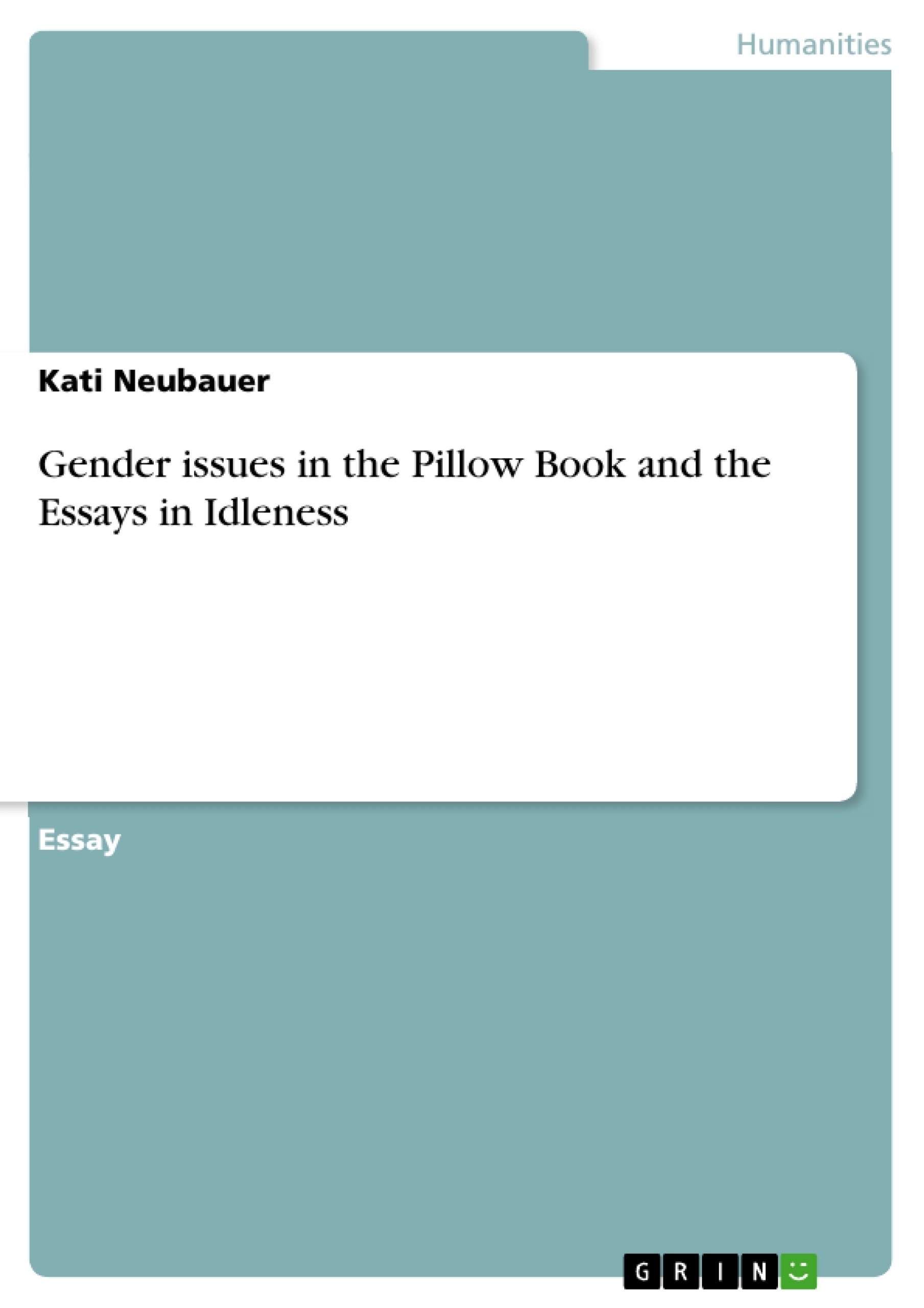The Pillow Book (PB) by Sei Shonagon and the Essays in Idleness (EI) by Yoshida Kenko are both considered classic Japanese literature. Both books deal with the court life during their time period. While Sei Shonagon expresses a feminine view and Kenko a masculine opinion, a comparison between the Pillow Book and the Essays in Idleness can be made by bringing their thoughts towards the other sex in contrast to each other. Furthermore, a change in gender roles can be observed. The essay will lay open the reciprocal critics, but also show how deeply both authors fall for the other sex.
Gender issues in the Pillow Book and the Essays in Idleness
The Pillow Book (PB) by Sei Shonagon and the Essays in Idleness (EI) by Yoshida Kenko are both considered classic Japanese literature. Written in the Kamakura Period in the13th century, and therefore three centuries after the Pillow Book the Essays in Idleness even have a reference to Sei Shonagon’s literacy work (EI, 3). Both books deal with the court life during their time period, describe events taken place at the Imperial Court, express opinions of nobles, and illustrate the authors own personal judgements. While Sei Shonagon expresses a feminine view and Kenko a masculine opinion, a comparison between the Pillow Book and the Essays in Idleness can be made by bringing their thoughts towards the other sex in contrast to each other. Furthermore, a change in gender roles can be observed. Even though, Sei Shonagon has the standing in today’s review to be a “man hater”, she expresses her dislike toward certain behaviour across gender and age borders and just addresses male behaviour sharply when her own status is affected. On the contrary, Kenko roughly attacks women in general. The following essay will lay open the reciprocal critics, but also show how deeply both authors fall for the other sex.
Written in the 10th century, the Pillow Book provides an insight to the female attitude toward male mainly in their roles as lovers. Therefore, Sei Shonagon finds it unpleasant if the lover’s attendants don’t know how to behave properly and spoil the romantic moment by chatting loudly, which is heard through the screens (PB, 82); she gives the advice that “[…] a man should take along only those attendants whose character is known to him” (PB, 82). She lays open that she dislikes snoring men when the couple already spent the night in “an unsuitable place” (PB, 45), aware that they could get caught. Also, as “Most hateful!” (PB, 45) she describes the vain behaviour of a secret lover, who doesn’t want to be seen by anyone but doesn’t leave without his big hat on, and than makes noise by banging the large hat into something (PB, 45). Also, she critics the effort of a man by dressing properly in every detail when leaving her in the middle of the night since she believes nobody will see or recognize him during this late hour anyway, which makes his action dainty to her (PB, 49). A similar situation she dislikes, as revealing an unnecessary attitude of a man, is when a lover can’t find his accessories, like a fan or paper in the dark before leaving, and makes loud noise (PB, 49). She describes those behaviours has hateful, since she can be affected negatively by them as well and could lose her reputation. She emphasizes the importance of “the elegance of his leave-taking” (PB, 49) and describes romantically how a good lover behaves. A good manner to her in leaving would be charming to the woman, achieved by showing his unwillingness to go but disappearing smoothly by leaving her with soft words (PB, 49). She praises men who immediately, after heading home, send a well-written letter back to the lady to adulate her (PB, 257). The author makes clear that she is more interested in a relationship that can be described as an affair. As soon as a man comes to a lady-in-waiting and demands to receive food she sees it as a permanent relationship, which to Sei Shonagon is inappropriate (PB, 254). On the other hand, she is upset about a man who makes a “helpless Court lady” pregnant without doing any future arrangements to support her (PB, 145). She is even speaking of the man as the one who is seducing the lady and therefore, clearly victimizes women. Sei Shonagon as well can’t bear men, who pretend to like a woman while it is clear that he doesn’t, since she relays on his words (PB, 144). She gives different behaviour codes for men and women though; if a couple splits up, it suits the man to show to the woman that he is sorry, while the woman can show him the cold shoulder without being called heartless in her opinion (PB, 144). Overall, Sei Shonagon describes secret romances with men as very pleasant. She describes her excitement when expecting a visitor (PB, 51/ 82),[1] notes the sentimental importance of letters of former lovers (PB, 51), and even mentions the summer time as her favourite season for having an affair (PB, 81). This demonstrates how important relationships between men and women in the daily court life are to her. But in their interaction, even in the most intimate relationship, she demands a form of etiquette to provide security and support the idea of romance (PB, 255/256).
[...]
[1] “A lover’s visit is the most delightful thing in the world.“ PB, 82.
- Quote paper
- Kati Neubauer (Author), 2008, Gender issues in the Pillow Book and the Essays in Idleness, Munich, GRIN Verlag, https://www.grin.com/document/133379




